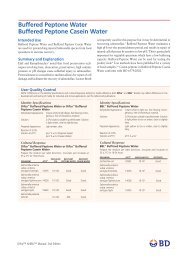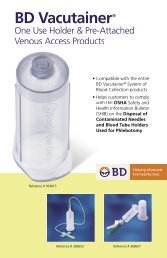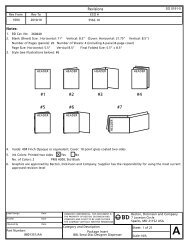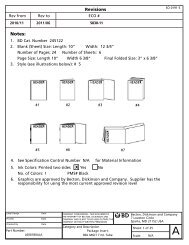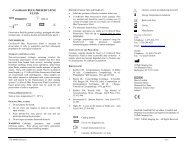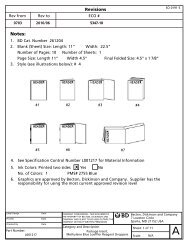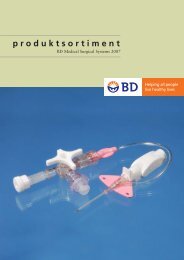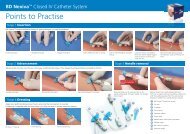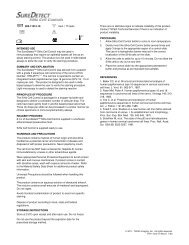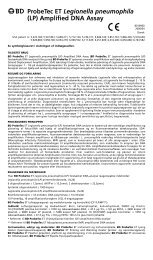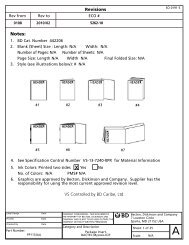Notes: - BD
Notes: - BD
Notes: - BD
Create successful ePaper yourself
Turn your PDF publications into a flip-book with our unique Google optimized e-Paper software.
BBLCrystal Identification Systems<br />
Anaerobe ID Kit 8809491JAA<br />
2010/07<br />
English: pages 1 – 10 Italiano: pagine 29 – 37<br />
Français : pages 11 – 19 Português: páginas 38 – 47<br />
Deutsch: Seiten 20 – 28 Español: páginas 48 – 56<br />
<br />
CLIA COMPLEXITY: HIGH<br />
CDC IDENTIFIER CODES<br />
ANALYTE: 0412<br />
TEST SYSTEM: 07561<br />
INTENDED USE<br />
The BBLCrystal Anaerobe (ANR) Identification (ID) System is a miniaturized identification method employing<br />
modified conventional, fluorogenic and chromogenic substrates. It is intended for the identification of frequently<br />
isolated anaerobic bacteria.1-9<br />
SUMMARY AND EXPLANATION<br />
Micromethods for the biochemical identification of microorganisms were reported as early as 1918.10 Several<br />
publications reported on the use of the reagent-impregnated paper discs and micro-tube methods for<br />
differentiating enteric bacteria.10-14 The interest in miniaturized identification systems led to the introduction of<br />
several commercial systems in the late 1960s, and they provided advantages in requiring little storage space,<br />
extended shelf life, standardized quality control and ease of use.<br />
In general, many of the tests used in the BBLCrystal ID Systems are modifications of classical methods. These<br />
include tests for fermentation, oxidation, degradation and hydrolysis of various substrates. In addition, there are<br />
chromogen and fluorogen linked substrates, as in the BBLCrystal ANR ID panel, to detect enzymes that microbes<br />
use to metabolize various substrates.12,15-22<br />
The BBLCrystal ANR ID kit is comprised of (i) BBLCrystal ANR ID panel lids, (ii) BBLCrystal bases and (iii)<br />
BBLCrystal ANR, GP, RGP, N/H ID Inoculum Fluid (IF) tubes. The lid contains 29 dehydrated substrates and a<br />
fluorescence control on tips of plastic prongs. The base has 30 reaction wells. Test inoculum is prepared with the<br />
inoculum fluid and is used to fill all 30 wells in the base. When the lid is aligned with the base and snapped in<br />
place, the test inoculum rehydrates the dried substrates and initiates test reactions.<br />
Following an incubation period, the wells are examined for color changes or presence of fluorescence that result<br />
from metabolic activities of the microorganisms. The resulting pattern of the 29 reactions is converted into a tendigit<br />
profile number that is used as the basis for identification.23 Biochemical and enzymatic reaction patterns for<br />
the 29 BBLCrystal ANR ID substrates for a wide variety of microorganisms are stored in the BBLCrystal ANR ID data<br />
base. Identification is derived from a comparative analysis of the reaction pattern of the test isolate to those held<br />
in the database. A complete list of taxa that comprises the current database is provided in Table 1.<br />
PRINCIPLES OF THE PROCEDURE<br />
The BBLCrystal ANR ID panels contain 29 dried biochemical and enzymatic substrates. A bacterial suspension in the<br />
inoculum fluid is used for rehydration of the substrates. The tests used in the system are based on microbial<br />
utilization and degradation of specific substrates detected by various indicator systems. Enzymatic hydrolysis of<br />
fluorogenic substrates containing coumarin derivatives of 4-methylumbelliferone (4MU) or 7-amino-4methylcoumarin<br />
(7-AMC), results in increased fluorescence that is easily detected visually15-19 with a UV light<br />
source.19-21 Chromogenic substrates upon hydrolysis produce color changes that can be detected visually. In<br />
addition, there are tests that detect the ability of an organism to hydrolyze, degrade, reduce or otherwise utilize a<br />
substrate in the BBLCrystal ID Systems.<br />
Reactions employed by various substrates and a brief explanation of the principles employed in the system are<br />
described in Table 2. Panel location in referred tables indicates the row and column where the well is located<br />
(example: 1J refers to Row 1 in column J).




